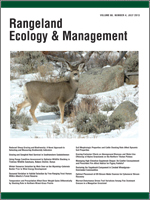Traditional upland livestock grazing is declining worldwide, leading to concerns about possible impacts on biodiversity. Although monitoring of protected areas often focuses on rare species, management changes also affect currently common species and vegetation structure. “Biodiversity” is a concept rather than a simple variable, and monitoring it requires indicators that are widely applicable and appropriate to context. This paper presents a novel knowledge-driven approach to developing a selection of biodiversity indicators that can then be rapidly and objectively measured within rangeland environments. Stakeholder and professional opinion on likely changes in biodiversity following reductions in sheep grazing was elicited using a workshop-based process. Potential variables suitable for use as biodiversity indicators were developed and professional opinion on their usefulness sought. A number of indicators were then tested in a natural experiment field study on the impact of reduced sheep grazing in Scotland. In the field study, red deer abundance appeared to increase where sheep grazing was reduced. It was therefore necessary to use estimates of both sheep and deer abundance as explanatory variables. In agreement with the professionals' predictions, dwarf shrub abundance and vegetation height were greater where sheep grazing had been reduced, after taking into account differences in deer. In contrast to the professionals' predictions, the field results showed rough grasses and dead material were less abundant where sheep had been reduced, with deer also having an impact on dead material. The professionals were unsure of the effects of reduced sheep grazing on vegetation mosaic structure; the field results suggested that reduced sheep grazing leads to a reduction in structural heterogeneity, but that deer had the greater impact in this case. Several other predictions showed nonsignificant differences in relation to reduced sheep grazing. The participatory method and some of the field methods presented are cost effective and widely applicable.
How to translate text using browser tools
1 July 2013
Reduced Sheep Grazing and Biodiversity: A Novel Approach to Selecting and Measuring Biodiversity Indicators
M. L. Pollock,
J. P. Holland,
C. Morgan-Davies,
J. Morgan-Davies,
A. Waterhouse
ACCESS THE FULL ARTICLE

Rangeland Ecology and Management
Vol. 66 • No. 4
July 2013
Vol. 66 • No. 4
July 2013
field methods
herbivory
joint learning
rangeland
stakeholder participation
structural heterogeneity




